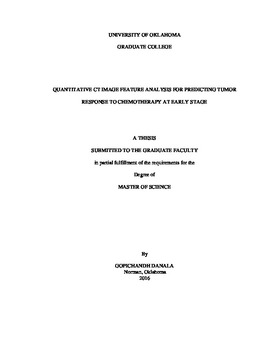| dc.description.abstract | In gynecologic oncology, ovarian cancer is the second leading cancer with highest mortality rate. Since most of the ovarian cancer patients are diagnosed at advanced stage occurred with metastatic tumors, chemotherapy is a necessary treating procedure after the aggressive surgery which removes the patient’s primary ovary tumor (Primary cytoreduction). However, currently, no method is able to effectively and efficiently predict the tumor response to the chemotherapy at an early stage (i.e. 4-6 weeks after the treatment). This study aims to investigate whether using quantitative image features computed from CT images enables to more accurately predict the response of ovarian cancer patients to chemotherapy. During the experiment, we retrospectively assembled a dataset involving 91 patients. Each patient had two sets of pre-and post-therapy (4-6 weeks follow-up) CT images. A computer-aided detection scheme was then developed, which is able to segment the metastatic tumors and computed image features. Next, we built two initial feature pools using image features computed from pre-therapy CT images only and image feature difference computed from both pre- and post-therapy images. The predicting performance of each feature was evaluated using the area under ROC curve, which is based on the criteria 6-month progression-free survival (PFS). Among these features, the optimal feature cluster was determined and an equal-weighted fusion method was used to generate a new image marker to predict PFS of the patients. The results indicate that the highest single feature AUC values are achieved as 0.6842 ± 0.0557 and 0.7705 ± 0.0495 respectively, which are computed from pre-therapy CT images only and both pre- and post-therapy CT images. When applying fusion-based image markers, AUC values significantly increased to 0.8103 ± 0.0447 and 0.8292 ±0.0431 (p < 0.05),respectively. This study demonstrated that it is feasible to predict patients’ early stage response to chemotherapy using quantitative image features computed from pre-therapy CT images. However, we can significantly improve the prediction performance when adding information from the 4-6 week follow-up CT images. | en_US |
